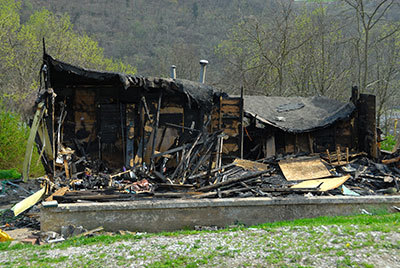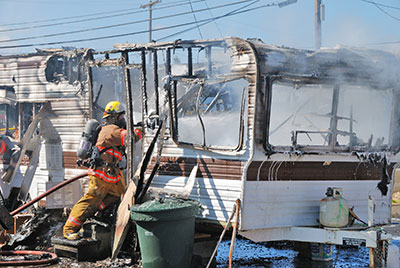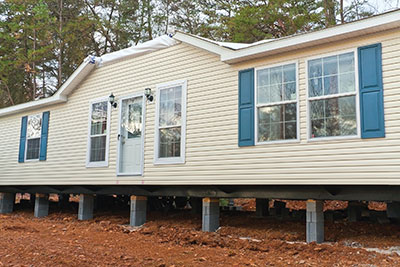
Features
Structural
Training
Trainer’s Corner: May 2014
A mobile home is a house that has been fabricated off site.
April 24, 2014
By Ed Brouwer
A mobile home is a house that has been fabricated off site. The house is placed on a steel chassis and is transported to the building site. The wheels can be removed but the chassis stays in place. Typically, mobile homes are built on lightweight wood frames with a thin aluminum shell covering, and are set up on concrete blocks, metal stands, wooden pillars or a concrete foundation.
 |
|
| Despite having less square footage, mobile homes are often packed with the same volume of belongings as a typical house.
|
Manufactured homes are essentially mobile homes, but with higher safety standards that were adopted by housing and urban development groups in 1976. The thin aluminum siding was replaced with wood siding or chicken wire and stucco, and the roof has a slight pitch or is flat. Three models of manufactured homes are available: single, double and triple wide.
Although mobile homes are smaller in square footage than homes that are built on site, people still seem to pack in the same volume of contents as they do in a typical house. This combination (small room sizes and large fire loads) promotes rapid fire growth and quickens flashover. Lower ceilings make fire spread extremely fast, creating multiple safety challenges for interior crews.
The following is taken from a National Institute of Occupational Safety and Health line-of-duty death (LODD) investigative report regarding a mobile home fire. It is hard not to get angry when you read this brutal account. How many more firefighters do we have to sacrifice to the fire dragon before incident commanders get their acts together?
“On January 11, 2001, a 27-year-old male volunteer fire fighter (the victim) died after becoming separated, disoriented, and lost as he and another fire fighter were trying to escape from the interior of a fully involved mobile home fire. Fire apparatus were dispatched to the site at 1110 hours, and at 1113 hours, the Chief arrived on scene in his privately owned vehicle (POV) and assumed incident command (IC). At 1122 hours, the first apparatus arrived: Engine 19 with the First Assistant Chief, a driver/operator, and two fire fighters (including the injured fire fighter). The Chief told them to set up in the driveway of the mobile home (Side 2), and pull two attack lines. At 1123 hours the next apparatus arrived: Engine 14 (mutual aid) with a driver/operator. Engine 14 set up his apparatus behind Engine 19, and prepared to supply water. At 1125 the final two apparatus arrived: Engine 15 (Captain and two fire fighters) and Engine 16 (Captain, Lieutenant [the victim], driver/operator, and one fire fighter). Both engines set up their apparatus and awaited instructions.
“The IC sent two crews to attack the fire–one crew entered the basement (Side 2), and the second entered the main floor from the porch (Side 1). The victim and the fire fighter from Engine 15 were in the first crew; they moved their attack from the basement to the porch, and then moved into the structure. A fire fighter from Engine 19, who was originally in the basement, joined them, and the three fire fighters moved down the hallway toward a back bedroom. The low-air alarm went off on the fire fighter from Engine 15, and he exited the mobile home to change his air bottle. The victim and remaining fire fighter hit the fire in the back bedroom until conditions deteriorated, and intense heat and smoke forced them to quit the interior attack and try to leave the structure. The deteriorating conditions also forced the second crew to quit the interior attack, and they were able to exit the home.
 |
|
| Mobile homes and trailer homes are often constructed of lightweight materials and have low ceilings, allowing fire to spread extremely quickly through the structure.
|
“As the victim and fire fighter from the first crew were trying to exit, thick smoke banked down to the floor and the heat intensified further, forcing them to follow the handline on their hands and knees. However, the line had looped over itself several times, and the two fire fighters became disoriented, got off the line, and crawled into an addition (12 ft x 12 ft) to the mobile home. The fire fighter from Engine 19 found a window, broke through it, and fell outside the mobile home. Other fire fighters assisted him, and he was transported to the local hospital, at 12:02 hours.
“Between 30 and 40 minutes elapsed before it was determined that the victim was missing. At this time, several fire fighters began searching the grounds and the interior, and even called the local hospital to see if the victim had been transported there with the injured fire fighter. The victim was eventually located by a chief from one of the mutual aid departments, who crawled into the addition and saw the victim’s boot. His body was removed to the outside and he was pronounced dead at the scene by the local coroner.” (NIOSH report F2001-04 – www.cdc.gov/niosh/fire/reports/face200104.html)
No complete size-up, no continual evaluation of fire conditions, no accountability, no PAR, no PASS alarm, no RIT, no safety officer, no mayday, no radio – no chance!
The victim had 10 years of firefighting experience. His helmet was found by another firefighter and given to the assistant chief, who then began a search. No one knew he was in trouble. Although he had become lost and disoriented, no distress or mayday call was ever heard. He was wearing a PASS device but it had not been turned on and his radio was found in his turnout pants pocket, where it is hard to reach.
I know this was 12 years ago, and many of these safety issues have been addressed – we now train to a higher standard that includes PAR training, evacuation alerts and RIT, and our equipment now has built-in PASS alarms. However, the question I spoke out loud as I read this was, “Why the heck are we sending firefighters into these situations in the first place?” It is a valid question, especially when you read that the female who reported the fire told the chief, upon his arrival, that everyone was out of the house.
NFPA 1500 explains that we may risk a lot to protect savable lives, we may risk a little to protect savable property, but we will not risk our lives at all for property that is already lost.
An additional danger with mobile homes, especially the older ones, is that the structure may have had any number of remodels and additions. Take the preceding incident as an example. The original mobile home was a single-family residence measuring 3.6 metres wide and 19.8 metres long. Then it was placed on a concrete-block foundation measuring 7.3 metres wide, 19.8 metres long and was 2.1 metres in height to create a basement. The basement was partitioned off and consisted of finished living quarters on the east side and a workshop area containing a garage on the west side. It was a wood-framed building with aluminum siding and a flat roof with metal roofing, and was fully carpeted. An enclosed porch measuring 3.6 metres wide and 13.1 metres long, and a 3.6-metre by 3.6-metre addition had also been attached to the home. One dangerous modification was the addition of a pitched roof over the flat metal roof of the single-wide trailer, which created a void and, without access, made fire suppression difficult.
This may be an extreme case, but it is not that uncommon. Take note of mobile homes in your area; you may be hard pressed to find any that do not have some kind of addition or, worse yet, multiple additions. Many of these homes are nowhere close to being up to fire and building codes.
When dealing with a mobile-home fire:
- Conduct a complete size-up of the incident before initiating firefighting efforts
- Give careful consideration to type of construction, age of structure, additions and exposures
- Continually evaluate the risk versus gain during firefighting operations; remember the primary purpose of the interior attack is to provide protection to possibly trapped occupants and to the crews searching for those occupants
- Entry teams should also conduct their own ongoing size-up
- Communicate your observations
- Read and re-read smoke conditions
- Maintain accountability for all personnel at the fire scene – this is paramount
- Establish RIT and keep it in position.
- Appoint an incident safety officer to assess hazards or potential hazards
- Ensure firefighting tactics and operations do not increase hazards on the interior (for example: opposing hose streams may inadvertently push the fire in the direction of other hose crews)
- Leave hoselines in the structure until all crews have exited
- Firefighters entering the structure should be equipped with an easily accessible radio that is turned on
- Co-ordinate ventilation operations with the fire attack; remember the weak roof system
- Do not underestimate the danger because “it’s just a trailer.”
Positive pressure ventilation: Horizontal ventilation may be your safest bet, but even that may prove difficult. Most mobile homes sit up off the ground, making it difficult to get an effective cone at the door from a PPV fan. I caution against vertical ventilation because the mobile home roof is commonly made of only 38-millimetre by 38-millimetre rafters.
Hidden hazards: Due to the limited space for storage in mobile homes, occupants often store items under the home. A piece of plywood fastened to the vinyl skirting is a good indicator of sub-level storage, where it is not uncommon to find spare car tires and lawnmowers.
 |
|
| Due to the limited space for storage in mobile homes, occupants will often store items – such as spare car tires or lawn mowers – under the home.
|
On May 13, 2002, at 02:04, we responded to a mobile home fire. Although it had all the outward appearances of a family dwelling – complete with kids’ toys and outdoor furniture – the house turned out to be a full-blown grow-op. The 3.6-metre by 19.8-metre mobile home was completely gutted and then filled with marijuana plants and grow equipment. Compartments measuring 3.6 metres by one metre had been built on the trailer ends, complete with curtains, furniture and wall decor. These false fronts hid the grow op from public view (for more information on this operation, see page 11 in the February 2003 issue of Fire Fighting in Canada).
Liquefied petroleum gas (LPG) hazard: In many cases, cooking and heating for the home is provided by propane. Look for large propane tanks near the unit (usually behind). Pre-planning helps locate these dangers.
Our city has several mobile home communities or trailer parks. The access roads and driveways are narrow and resident parking is limited, so fire apparatuses have a small space in which to turn around and manoeuvre. The closeness of neighbouring mobile homes is also a concern; exposure protection is a top priority when dealing with a fire in the trailer park. Using Class A foam on exposures can be a game changer, due to the foam’s cooling ability, vapour suppression abilities, and its insulating and clinging characteristics, among other properties. There are no real specialty tools, but we did design and fabricate a piercing nozzle (for more information on piercing nozzles, see the TECHSmart section of the September issue of Fire Fighting in Canada). It takes two firefighters to adequately use this tool, but it enables us to apply water directly into burning rooms through the mobile home’s lightweight exterior, while the operating firefighters are safely outside.
The thoughts of dealing with a mobile home fire may be a little overwhelming, but don’t despair. Victory loves preparedness, so with the right equipment, proper training and pre-planning you will have a much greater chance of success and firefighter safety.
Until next time, keep up the good work training like lives depend on it.
Suggested training topics:
■ Size-up
■ Firefighter assist and survival: following a hoseline to safety, feeling the hose couplings for exit direction, turning a window into a door, moving a downed firefighter in limited space and moving firefighters down ladders or from below the floor
■ Mayday protocol: when to call and how to call
■ RIT: small windows, small rooms, tight spaces, narrow hallways and lightweight construction
■ Fire-ground communications: review radio operating procedures
■ Ventilation and fire attack
■ Class A foam
■ Overhaul and salvage
■ Pre-planning
■ Mobile home construction and floor plans
■ Evacuation alerts: audible warning and emergency radio traffic
Ed Brouwer is the chief instructor for Canwest Fire in Osoyoos, B.C., and Greenwood Fire and Rescue. The 25-year veteran of the fire service is also a fire warden with the B.C. Ministry of Forests, a wildland urban interface fire -suppression instructor/evaluator and an ordained disaster-response chaplain. Contact Ed at ebrouwer@canwestfire.org
Print this page